The first part of this blog outlined the British preparations for the occupation and defence of Crete, as well as the many relevant sources available at The National Archives.
German preparations
The Germans planned to lead the invasion with their airborne troops, with men from a mountain infantry division following up, though the plan depended entirely on gaining control of at least one of the airfields. Some Italian forces were included in the operation as well. Two errors in the German plan were a significant under-estimate of the number of Allied troops on the island and the expectation that the Cretan civilians would not resist, and these mistakes contributed to their heavy losses during the invasion. AIR 23/6110 includes translations of captured documents from Operation Mercury.
The assault
The invasion began on 20 May, with airborne landings along the coast between Maleme and Heraklion, backed by heavy air attacks. Allied and civilian resistance was much stronger than expected, and by the first night of the battle the Germans had gained little except a precarious foothold at Maleme.
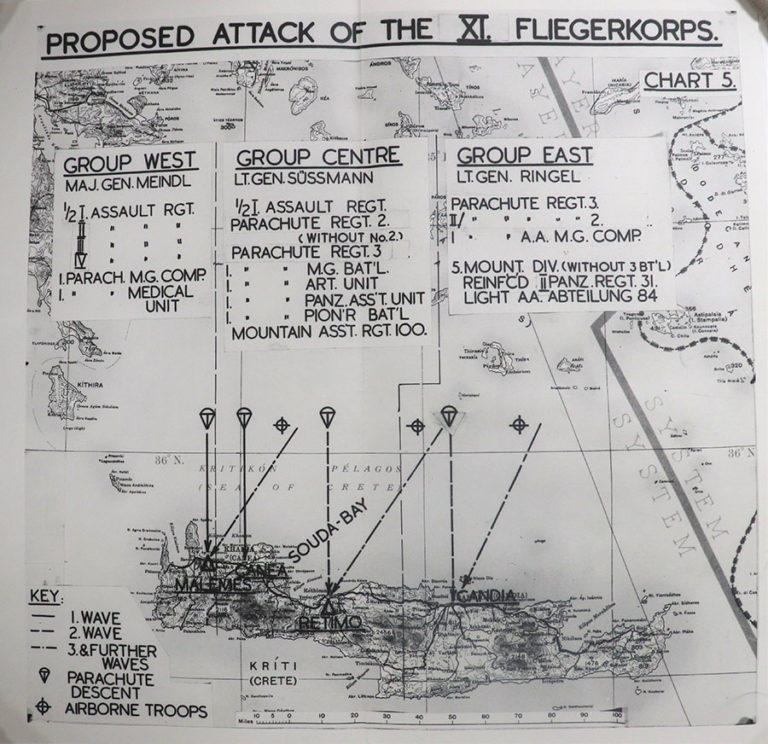
Elsewhere the Allies initially held the towns, harbours and airfields. Heraklion was defended by a British-Australian-Greek force under 14 Infantry Brigade (the original Creforce), and events at the airfield there were recorded in the 2 Battalion Black Watch war diary.
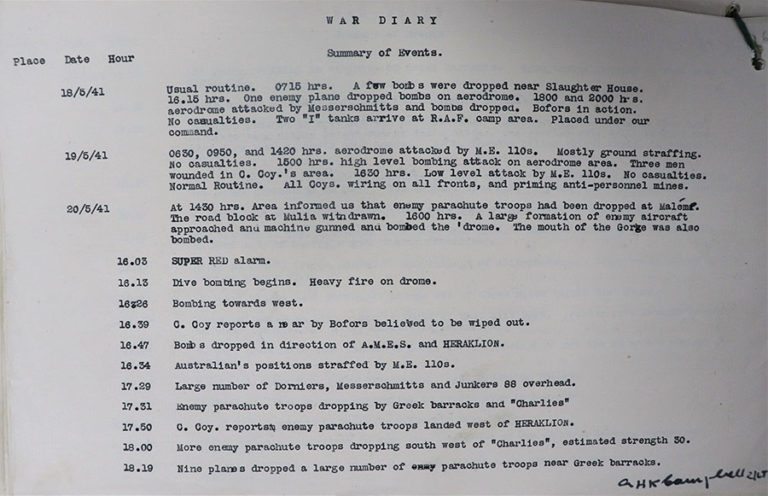
Suda Bay was defended by a mixed Allied force including the Mobile Naval Base Defence Organisation (MNBDO), a Royal Marine outfit. MNBDO records can be found in series ADM 202. 52 Light Anti-Aircraft Regiment was another unit in this area (WO 169/1640). The National Archives does not hold a war diary for the Australians at Retimo, though there is a related report at CAB 106/382.
The struggle for Maleme airfield
Maleme quickly became the crucial objective in the battle. The Germans were able to expand their foothold to gain control of the airfield and fly in more troops, while Allied counter-attacks faltered.
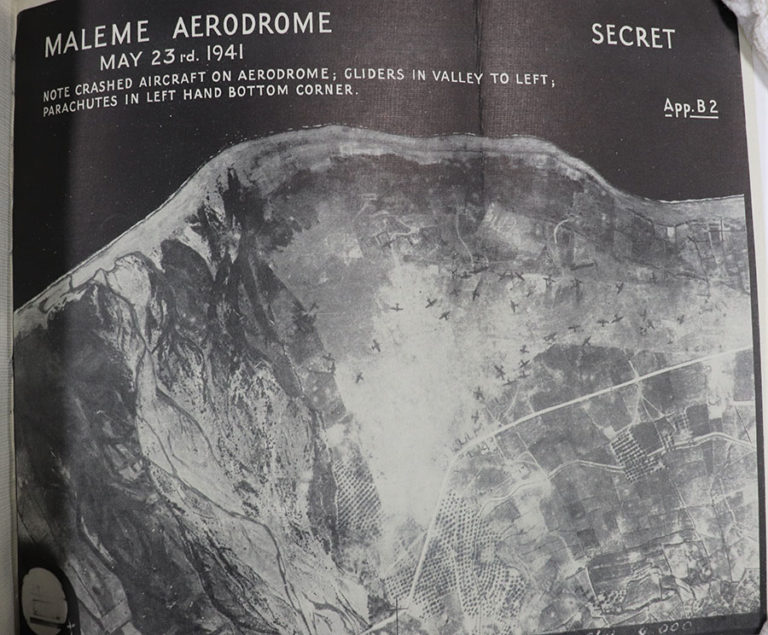
The aerial photograph above shows several German transport aircraft on the airfield just after it was captured. The action at Maleme is covered in an account from 2 New Zealand Division, as well as in the war diary of 22 New Zealand Infantry Battalion (WO 179/735).
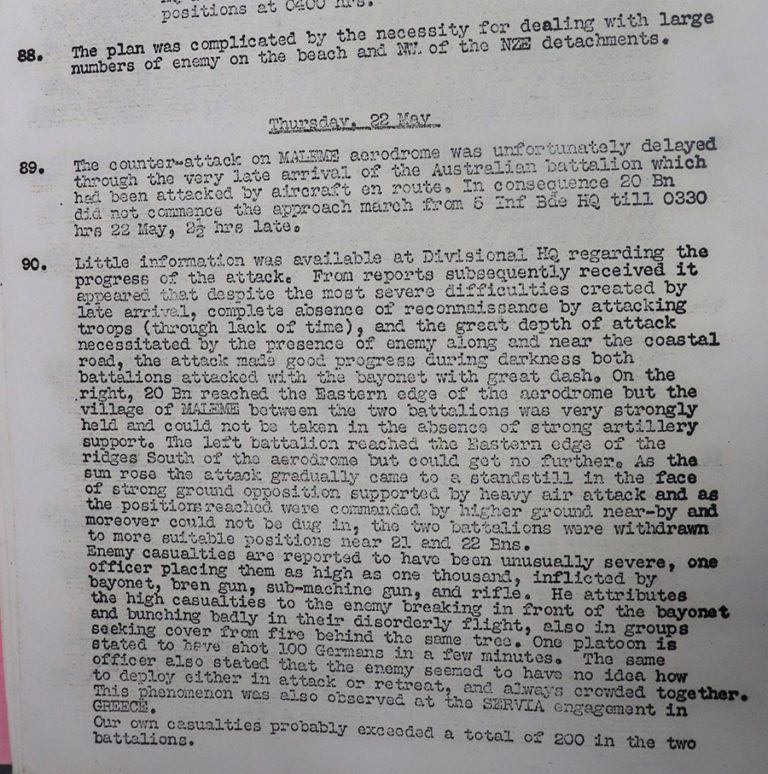
The air and sea battle
The battle was fought at sea and in the air, as well as on land. The Royal Navy faced fierce German air attacks but was able to intercept a force of seaborne German troops, embarked on requisitioned civilian vessels, before they could reach Crete. The first significant Royal Navy casualties happened on 22 May, when the light cruiser HMS Naiad was among the ships attacked.
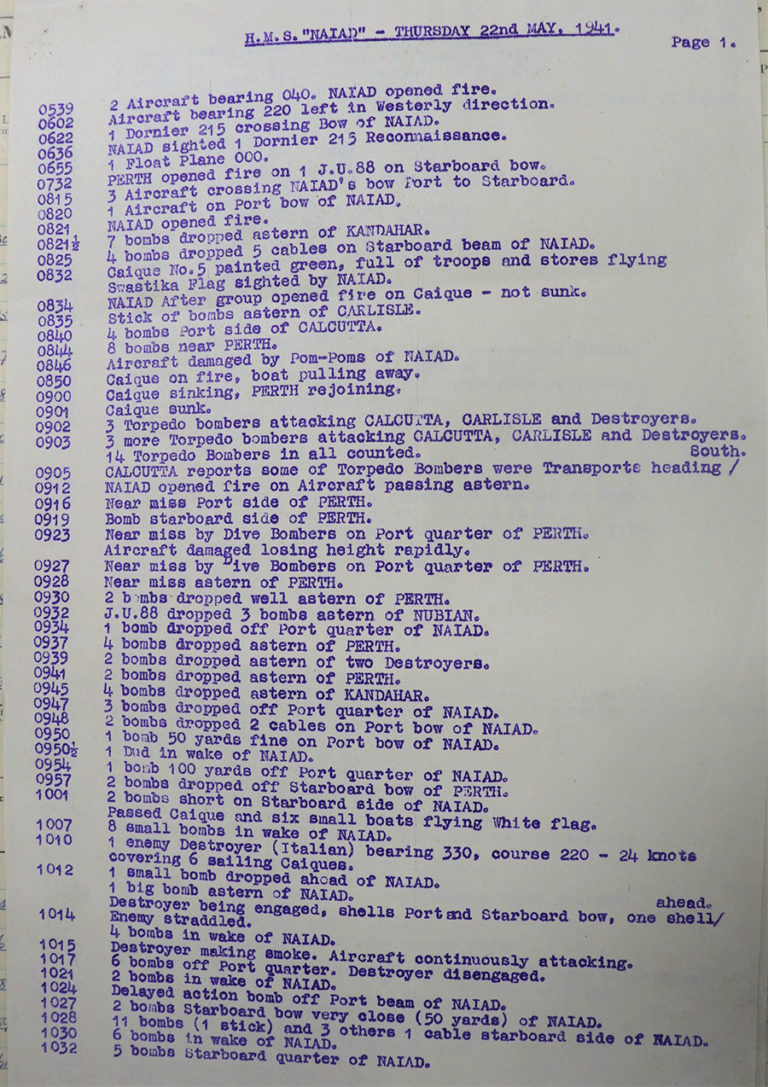
Several other British warships were sunk or damaged by air attack during the battle, and it became very difficult for the fleet to support the troops on the island. Only fast warships could go there by sailing at night and leaving before dawn, which limited the amount of cargo or troops that could be sent.
Despite the weakness of the RAF, some squadrons did take part in the battle. 45 Squadron, with Blenheim light bombers, flew sorties from Egypt against Maleme airfield after it was captured. The squadron operation record books list the aircraft and crews that were involved, and these records can usually be downloaded from The National Archives’ website.
The 45 Squadron account can be seen at AIR 27/455/11 and some other AIR (Air Ministry) sources for Crete in this period are listed here.
Defeat and evacuation
Following the loss of Maleme the Allies fell back to regroup, but within a few days the situation deteriorated as the Germans began to push towards Canea, threatening the supply base at Suda Bay. They were also still holding ground outside Retimo and Heraklion, and their air attacks put the Allied troops under great strain throughout the battle. Among the few Allied reinforcements to arrive was a commando outfit known as Layforce, which included the author Evelyn Waugh. These troops were meant to carry out raids but instead had to be used as a rear-guard once the withdrawal began. There are some records relating to Layforce listed in our catalogue here.
On 26 May Freyberg sought permission to begin an evacuation of his forces, as he considered the situation hopeless. Wavell quickly agreed, after sending a signal to the Prime Minister stating that Crete was ‘no longer tenable’.
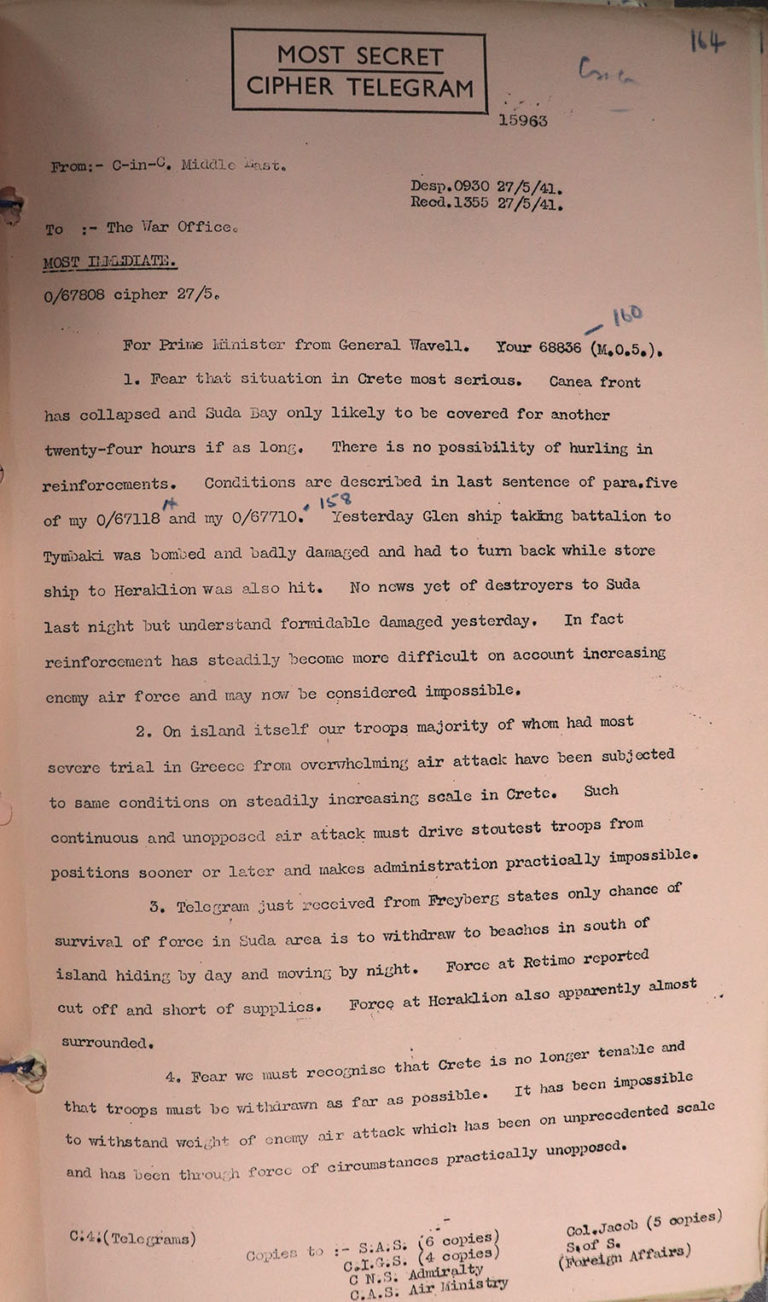
The evacuation took place between 27 May and 1 June. The largest group of men had to retreat to Sphakia, a hamlet on the south coast, to be met by the Royal Navy. General Freyberg was among them, because he knew about the secret Enigma decrypts and could not be left behind as a prisoner. Other men were picked up from Heraklion, though they still faced German air attacks and the light cruiser HMS Orion, carrying more than 1,000 troops, was among the ships bombed. Some sources for the casualties from this attack are listed in our catalogue here. It was not possible to evacuate all the men and many were left behind, including those trapped at Retimo. The Royal Navy’s part in the evacuation is covered in a report from the Mediterranean Fleet:
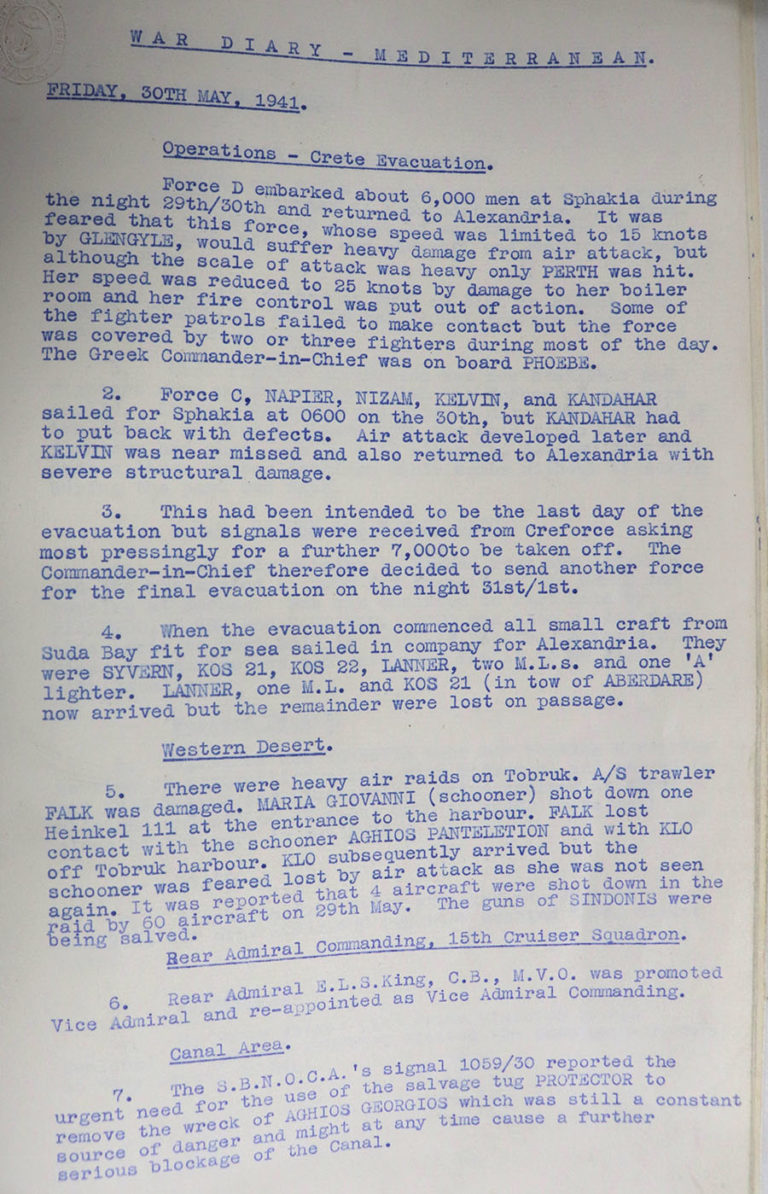
Aftermath
The loss of Crete took place at a time when various other commitments and operations required resources from Wavell’s command, often taking higher priority than Crete itself. Soon after the battle the Inter-Services Committee produced a report into the defence and loss of the island. Wavell added a note acknowledging that the preparations before the battle had been insufficient. The extract shown here covers the fighting at Retimo.
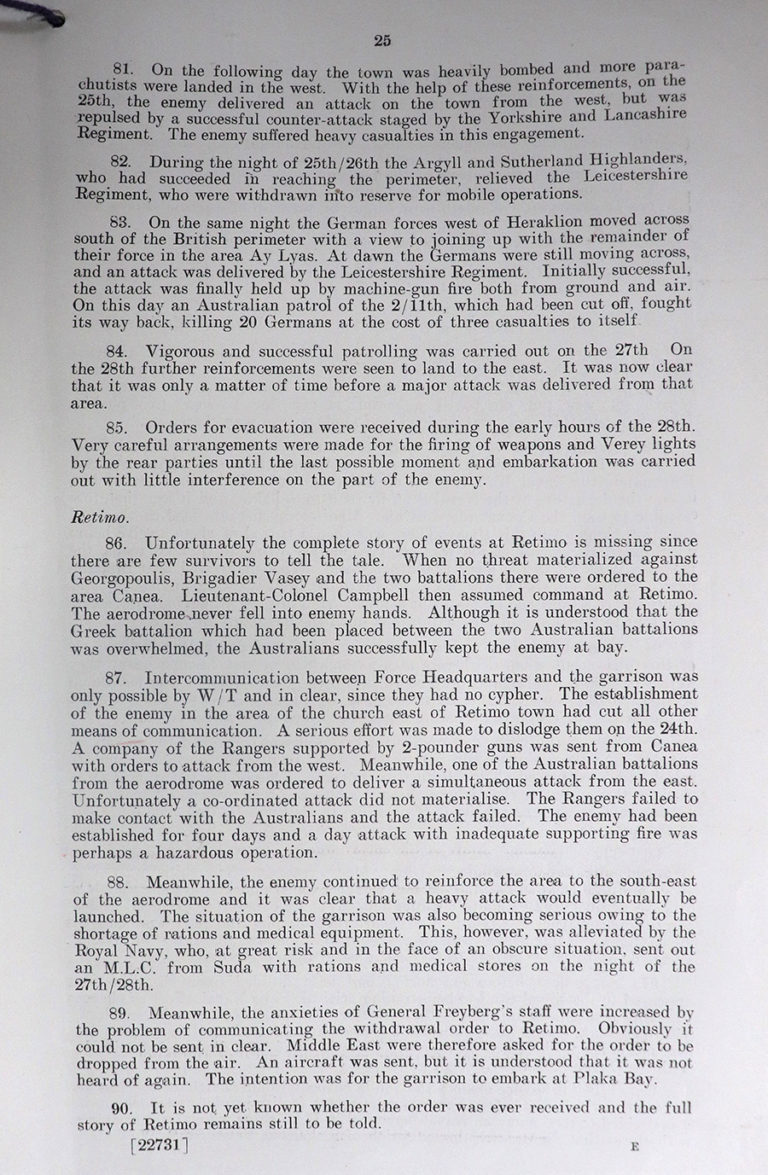
Other sources covering lessons from the battle can be found in our catalogue, such as WO 287/164.
The National Archives also holds various sources for Allied prisoners, casualties and gallantry awards relating to Crete. WO 416 is a series of German prisoner of war record cards, often showing place of capture. A sample list of Welch Regiment personnel in this series can be found in our catalogue here. There are also aircrew casualty files from the battle in series AIR 81.
Recommendations for army gallantry awards are mostly in series WO 373, which can be searched by theatre of operations as well as by name. WO 373/27/344 is a recommendation for a Military Medal for Stanley Lawrence Carroll, an Australian signalman who escaped from Crete by himself. Victoria Cross recipients are mostly covered separately, in series WO 98.
The War Illustrated magazine published an article about Crete on 20 June 1941, and our library has a set of the volumes of this publication.
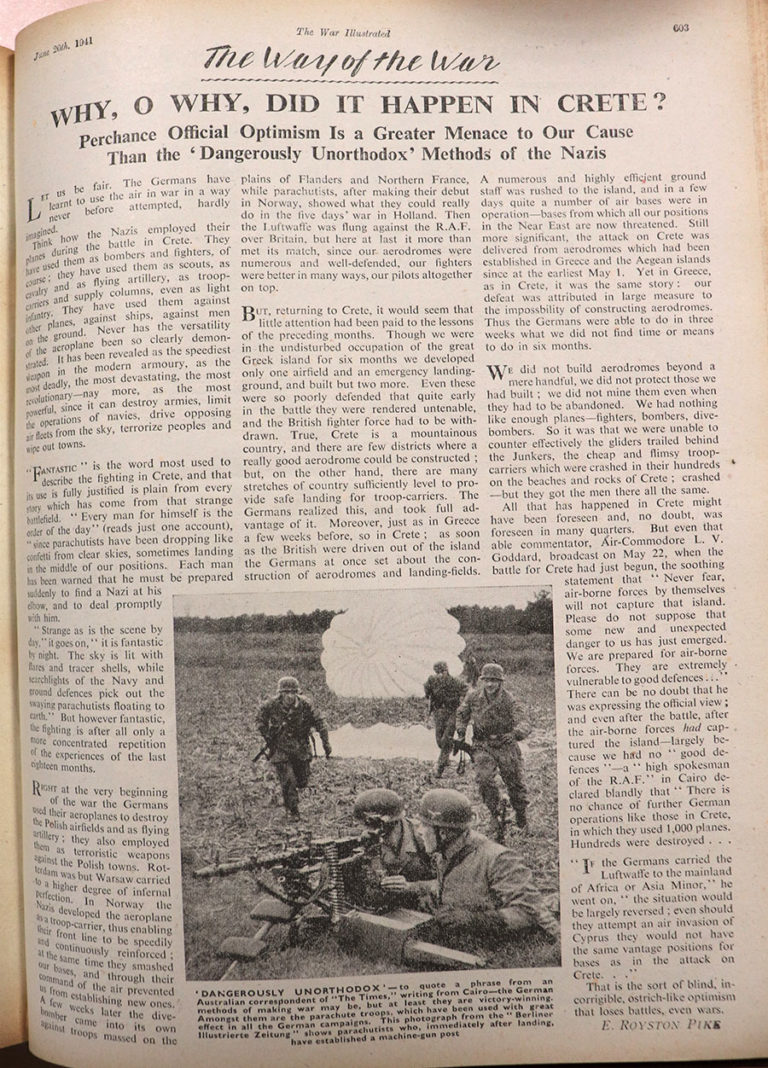
Conclusion
With the numerous sources available at The National Archives, there are many ways to find information covering the occupation of Crete, the battle itself and the men who took part. Though there are a few gaps in the records, such as the lack of Australian war diaries, the examples shown in this blog are a representative sample of what is available.
Also not all of the files are open, even after this amount of time.
The War Diary of 22 Battalion 2NZEF who defended and lost Maleme can be found at
http://22battalion.org.nz/war-diary/1941-may.htm
In a July 2023 visit to the Allied War Cemetery at Suda Bay in Crete we were moved to bump into a small group of Scots who had come to Crete to honour the wishes of the grandfather of one of their party. He had been a member of the Black Watch of Scotland and had fought in Crete during WW2. He had recently passed away and his wish was to have his ashes scattered alongside those of his fallen mates. How can we stop wars!
During my time in the Colonial Service, (N.NIGERIA) I was very friendly with an Australian who was in the battle of Crete. He rarely spoke of any of his war experiences but on one occasion we were talking and he told me a little of that time. He was in command of men trying to get off the island during its evacuation. It was all very tense and there were not enough boats for the evacuation and because of the conditions, he had to maake the decision that only those who could carry their arms were able to board the boats. Our coversation was in 1956 and I think it still haunted him that so many men were left brhind
While serving as a USMC officer in 1956 aboard ship in the 6 th fleet we conducted military exercises ashore at Suda Bay. We met several of the locals who took us to various locations where British, Australian and local inhabitants made their stands. Many were lost and some were even executed in a nearby cave after being captured. The hopelessness of their situation but the determination and bravery displayed by those who fought back has made a lifelong impression of all those brave souls.
My father was with ROAC and I have discovered he arrived at Port Said on 04/04/41 as apparently part of 2nd Ech, m.e. I know he was captured on 01/06/41 in Crete. I am trying to fill in the gap. How and when did he get to Crete? Where was he in Crete? Where was when a young German soldier told him on the 1st June 1941 ” For you the war is over”